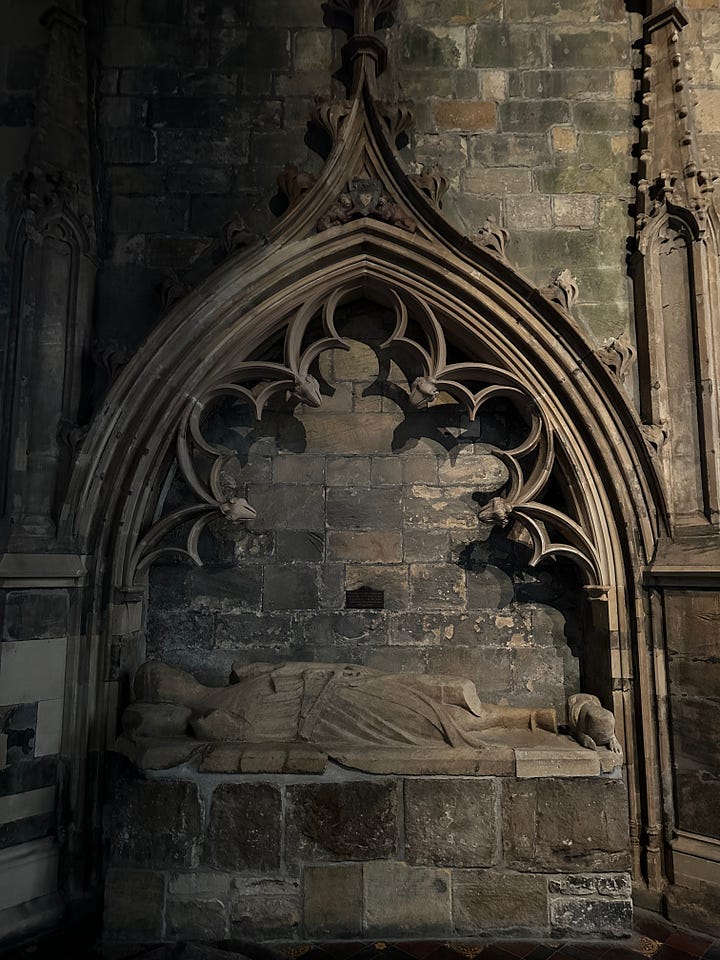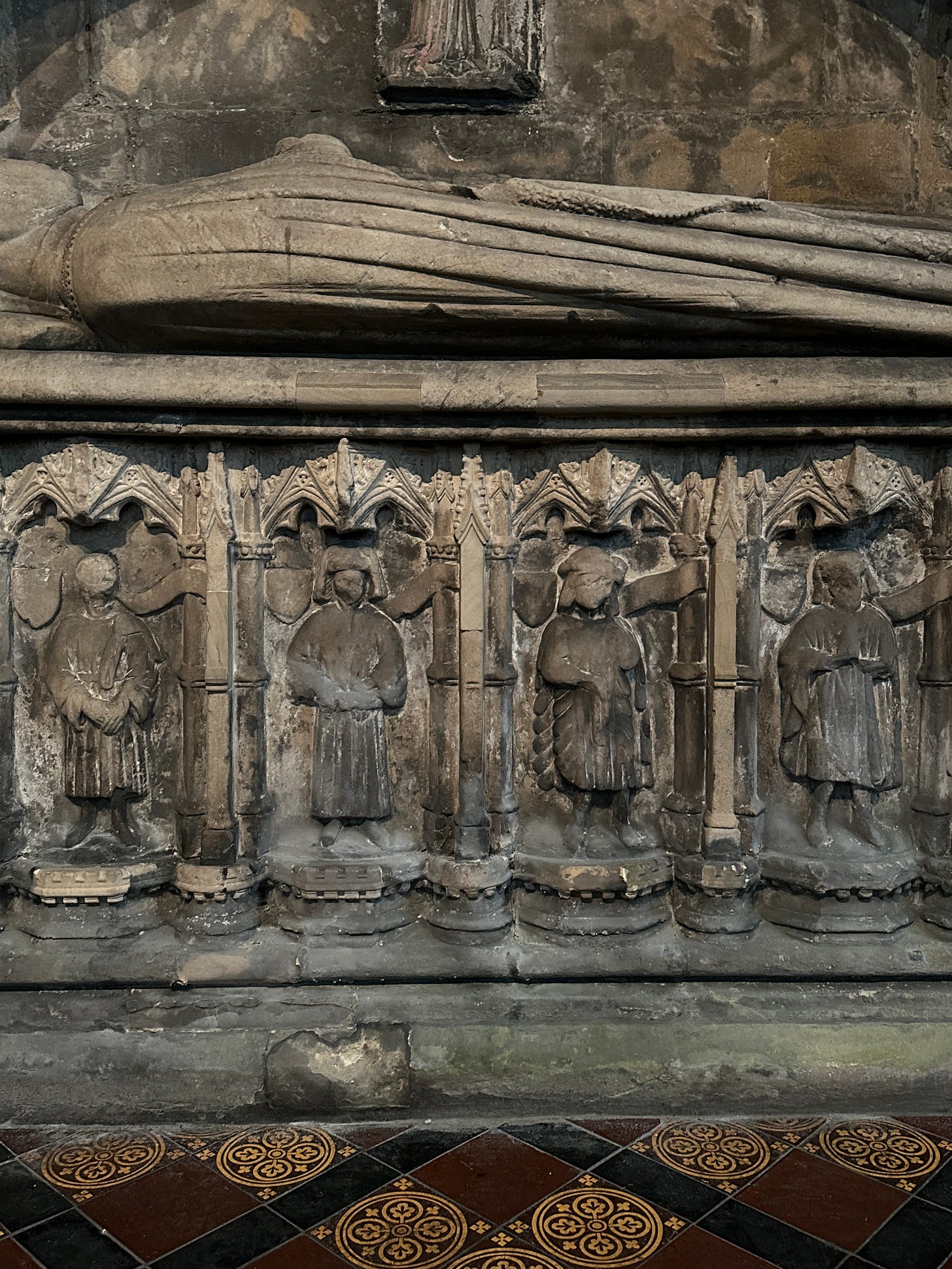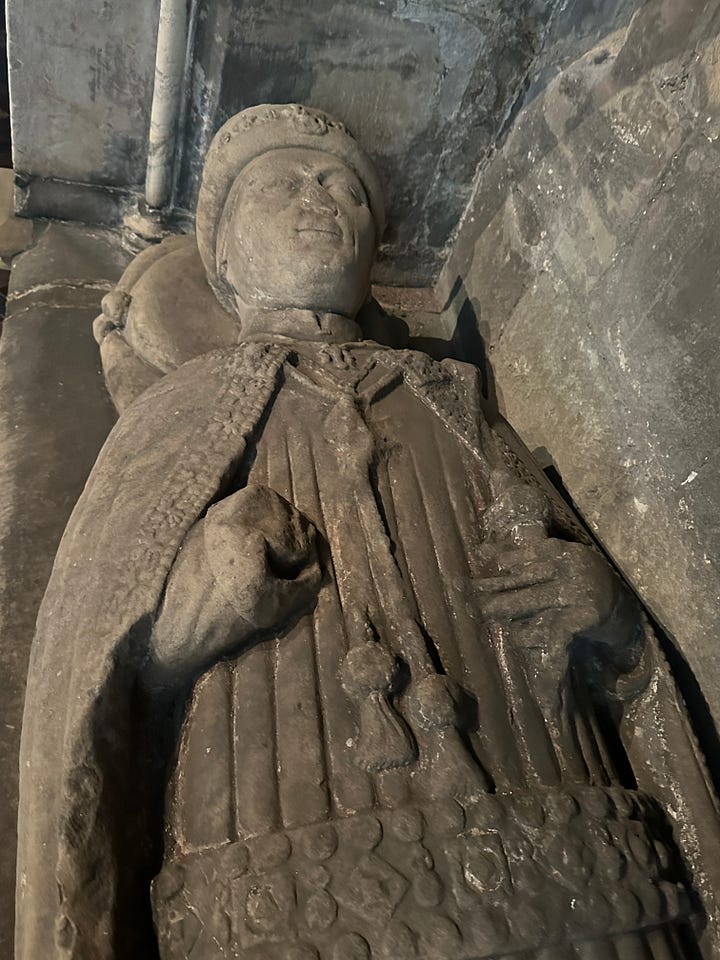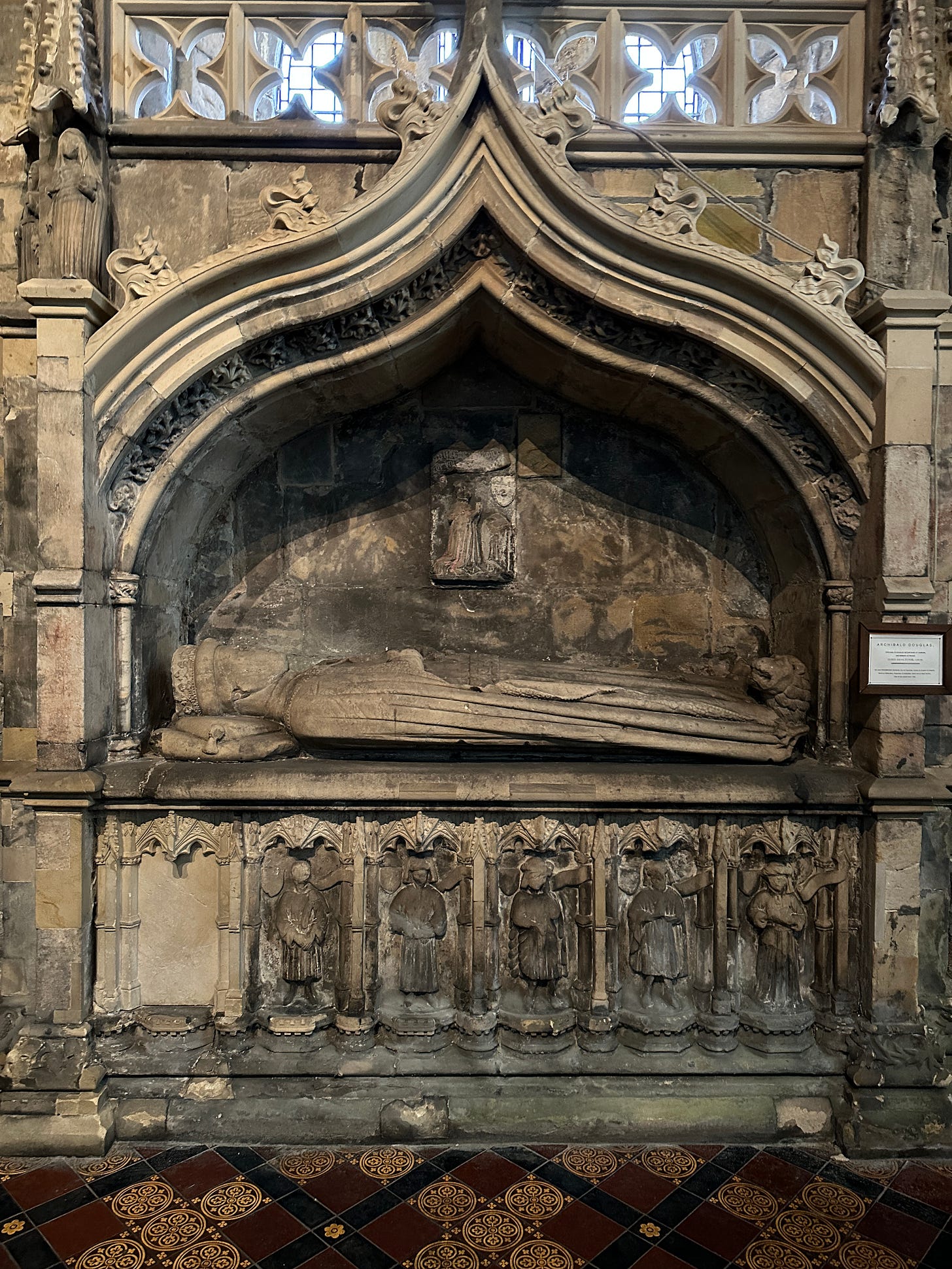The Black Douglases of St Bride's Church (Part Four)
A small church in southern Scotland contains the mausoleum of medieval Scotland's most powerful noble dynasty. Let's meet them. This is Archibald Douglas, 5th Earl of Douglas and 2nd Duke of Touraine.
Hello, I’m Beth! I’m a full time creator based in the Cairngorms in love with Scotland and Scottish history. Subscribers receive weekly newsletters about Scotland’s history and folklore, and a little about my life living and adventuring in this country. If you’d like to support my work as a writer, you can become a paid subscriber.
Interested? Click subscribe…
Welcome back to my mini-series exploring the tombs of the Black Douglases in St Bride’s Church. If you’re new here and have a few questions (who were the Black Douglases? Where is St Bride’s Church?), you can access the full series so far on my Substack.
St Bride’s Church contains three Black Douglas tombs. Last week we explored the 14th-century tomb of James ‘the Black’ Douglas, an icon from Scottish history and the founder of this dynasty who was prominent in the Scottish Wars of Independence from 1306 to 1330.
This week, let’s jump forward a little in time to the 15th century, to explore the tomb of Archibald Douglas, 5th Earl of Douglas and 2nd Duke of Touraine.
Archibald was the eldest son of Archibald ‘the Tyneman’ Douglas, 4th Earl of Douglas, and Princess Margaret Stewart of Scotland. His father was a formidable warlord, much like many of the heads of the Black Douglases, with a military reputation that extended beyond the Anglo-Scottish border and onto the continent. Furthermore, his grandfather was Archibald ‘the Grim’; bastard son of James ‘the Black’ Douglas and military and political heavyweight. The careers of both Archibald ‘the Grim’ and Archibald ‘the Tyneman’ had a significant impact on the Black Douglases and swept forward the legacy of James ‘the Black’ Douglas. From his birth, our Archibald had rather large shoes to fill.


A key theme that we identified last week in understanding the immense power of the Black Douglases was military strength. This was an essential pillar of the rise to power of this family, with their ability to lead in warfare, but also protect their adherents, a key justification for their position. In summary, for a family that forged their reputation in war with England, strength in war equalled strength in wealth and influence. It is crucial to remember this as we explore the life and career of Archibald Douglas.
In the early 15th century, violence between Scotland and England changed. The direct conflict of the Scottish Wars of Independence had not quite ended in 1357 with David II’s release from English captivity, with war continuing to rumble between the two kingdoms beyond 1400. However, another conflict became the source of warfare for military families like the Black Douglases: the Hundred Years’ War.
It is impossible to thoroughly summarise the Hundred Years’ War in a single Substack, but essentially, this was a conflict between the royal dynasties of Plantagenet and Valois for control of the throne of France, the wealthiest kingdom in western Christendom. Beginning in 1337, this warfare lasted (with intermittences for various reasons, such as the Black Death) until 1453 and transformed the political and military European stage.
Importantly, the Hundred Years’ War offered a solution to Scots whose very status had been established by the domineering violence and politics of the Scottish Wars of Independence: employment. For a family like the Black Douglases, involvement in this conflict was an obvious path to follow.
This is where our Archibald Douglas’ career began. Kickstarting his military experience in a fashion almost as impressive as his forefathers, in 1419 Archibald co-lead a Scottish army to join the Dauphin of France against Henry V of England. His fellow leader was his brother-in-law, John Stewart, Earl of Buchan, and from 1419 to 1421 these two men commanded roughly 15,000 Scots in France. The leadership of these two brothers by marriage demonstrates the family and kinship networks of this Scottish army, made up of adherents loyal to the Black Douglas nexus.

Moreover, it demonstrates the powerful hand of Archibald’s father (who I’ll now refer to as the Tyneman for distinction between father and son). Despite never actually winning a battle, the Tyneman was a famous warlord with a military reputation across western Europe. He was described as being a giant of a man with only one eye, a testament of his sacrifices on the battlefield. Moreover, the Tyneman was a hugely powerful magnate in Scotland, whose position as a regional powerhouse had exponentially grown in the absence of a king. Scotland’s king, James I, had been in English captivity since 1406, leaving room for men like the Tyneman to gain unchecked power and negotiate with kingdoms like France and England. The Dauphin of France had approached the Tyneman and other powerful Scottish nobles for support against England, with the response being to send an army under Archibald Douglas and John Stewart of Buchan.
This Scottish army was a success. On March 22nd 1421, the Scots won a huge victory over the English at the Battle of Baugé. Not only was this an English defeat on French soil by a predominantly Scottish army, but the battle resulted in the death of Henry V’s heir, Thomas, Duke of Clarence. In the aftermath of this victory, the Scots became hailed heroes by the Dauphin of France, recognising them as the most successful part of his army. Pope Martin V even dubbed the Scots as ‘an antidote to the English’.
After Archibald's success at Baugé, the Tyneman set his sights on increasing his own influence in France. By early 1424, Archibald had returned home to Scotland to act as his father’s lieutenant, while the Tyneman himself sailed to France to fight under the Dauphin, now crowned King Charles VII. Charles welcomed the Tyneman in a manner that is surely evidence of this Douglas magnate’s political, financial, and military significance: he was named lieutenant-general in war with England and granted the French duchy of Touraine.
The astonishing significance of this cannot be stated enough. In a completely unprecedented move, Charles had granted one of the wealthiest duchies in France to a foreigner with no royal connections to the Valois dynasty. This was a duchy that was usually reserved for French royalty. It had been handed on a silver platter to one of the most formidable military figures in Europe, a Scotsman born of the bastard of James ‘the Black’ Douglas. If this does not tell us of the Black Douglas military reputation in Europe, then I’m afraid nothing will.
This zenith of Black Douglas power did not last long. On August 17th 1424, the Tyneman was killed at the Battle of Verneuil against England. He perished alongside his younger son, James, and his son-in-law, John Stewart of Buchan, and around 6,000 other Scots. Most of this number were connected to the Black Douglases. It was a military and political disaster for the family,
Archibald, now 5th Earl of Douglas, inherited the disaster of his father's death in France, losing significant military and political support. As we have established so far in this series, military power was the justification and essence of Black Douglas power. In losing this, Archibald was faced with the shocking prospect for the first time in decades of a loss of influence in Scotland.
This devastating loss could not have been more poorly timed. In early 1424, James I of Scotland returned to his kingdom after 18 years in English captivity. The prodigal king wasted no time in asserting his royal authority over the nobility who had been left unchecked since 1406, violently removing his enemies and gradually chipping away at the authority of those who weren’t his enemies, but weren’t necessarily his friends. Archibald fell into this latter camp, and from 1424 to 1437 suffered severe loss of power under James’ regime.
In addition to battling for control in Scotland, Archibald was also struggling to maintain a Douglas voice in France. After his father’s death, Archibald petitioned Charles VII for his hereditary rights to the duchy of Touraine. These rights were refused, with Charles regranting the duchy to his sister-in-law. However, Archibald never relinquished the Black Douglas claim to Touraine, and despite never setting foot in the duchy, insisted that he keep the title of 2nd Duke of Touraine. You can identify the importance of this on his tomb at St Bride’s Church. He wears a ducal crown and robes, and is poised not as a warlord like his forefathers, but as a regal figure.


Archibald’s fortunes were to change. On the night of February 20th 1437, James I was assassinated in Perth. While Archibald did not have any role in the king’s murder, the involvement of Walter Stewart, Earl of Atholl, was symbolic of the general unhappiness that Scottish regional magnates felt towards their interfering king. In early May, after the coronation of six-year-old James II, Archibald was selected as lieutenant-general of Scotland, governing the kingdom until the young James was old enough to assume power.
This was a remarkable turn of events for Archibald, and provided him with the opportunity to recover the lands and influence of the Black Douglases which had been so badly damaged by Verneuil and James I’s royal policy. However, Archibald was not the only Douglas who took advantage of this situation. Through his entire career, one other Douglas figure had crept in the background: his uncle, James Douglas of Balvenie, later known in life as James ‘the Gross’.
James ‘the Gross’ appeared to have quite an incredible talent for capitalising upon the struggles of his Black Douglas kin, and knowing when to draw close to that kin or to criticise. For instance, from James I’s return in 1424, James ‘the Gross’ had coincidentally become a king’s man, despite the royal policy that sought to tear down the power of his nephew, the 5th Earl of Douglas. With the assassination of the king, James now slunk into Archibald’s favour, gaining reward from allying himself to the now lieutenant-general of Scotland.
On June 26th 1439, Archibald Douglas, 5th Earl of Douglas and 2nd Duke of Touraine, died suddenly at Restalrig after suffering a fever. He left behind two young sons: fifteen-year-old William, now 6th Earl of Douglas, and his younger brother, David. The fates of these two Black Douglas boys would be decided by the voracious appetite for power enjoyed by their great uncle, James ‘the Gross’ Douglas.
Until next week…
Beth xx





Why was his effigy lying on his side, do you know? Usually they are on their back? Excellent story Beth, loving this series.
Another great installment!